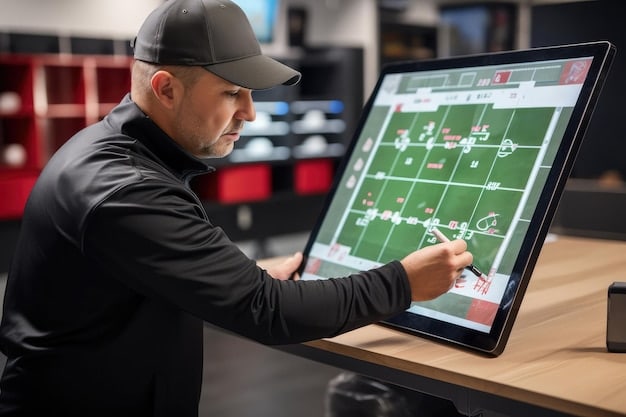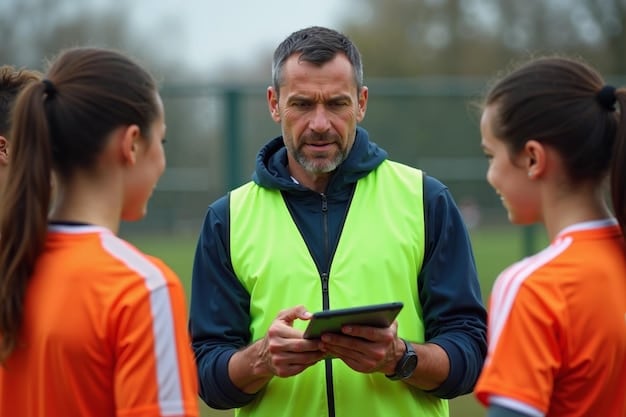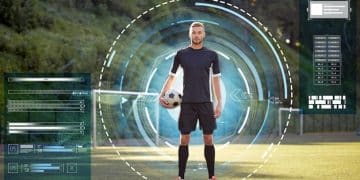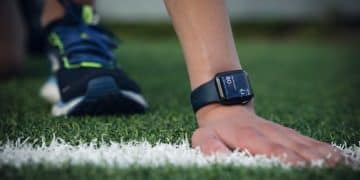GPS Tech Revolutionizes US Soccer Performance Tracking

GPS technology is fundamentally transforming US soccer by providing unprecedented data on player tracking and performance, enabling coaches to optimize training, prevent injuries, and enhance strategic decision-making in real-time.
The landscape of professional soccer, particularly in the US, is rapidly evolving. At the forefront of this transformation is the integration of advanced analytics, with GPS technology leading the charge in reshaping how teams approach player development and match strategies. Understanding How GPS Technology is Revolutionizing Player Tracking and Performance Monitoring in US Soccer offers a glimpse into the future of sports science.
The Dawn of Data-Driven Soccer: GPS Fundamentals
The adoption of technology in sports has been a gradual but relentless march, profoundly altering traditional training methods and game analysis. For US soccer, a sport rapidly gaining traction and sophistication, this evolution is particularly significant. At its core, GPS technology in soccer isn’t just about knowing where a player is on the field; it’s about quantifying every movement, every sprint, every deceleration, and every impact. This granular data shifts the paradigm from subjective observation to objective measurement, empowering coaching staff with unparalleled insights into player physical outputs and tactical adherence.
Understanding GPS in Sports
GPS (Global Positioning System) devices worn by players collect a multitude of data points. These small, lightweight units typically sit in a vest between the shoulder blades, ensuring minimal interference with movement while maintaining accurate signal reception. The precision of these devices has improved dramatically, now capable of recording data at high frequencies, often 10-20 Hz (times per second), capturing even subtle changes in movement.
- Device Functionality: Miniaturized GPS units capture satellite signals to pinpoint player location.
- Data Capture Rates: High-frequency sampling (up to 20 Hz) ensures detailed movement analysis.
- Wearable Design: Ergonomic vests ensure comfort and optimal data collection.
The raw positional data is then processed to derive a wealth of performance metrics. This transformation from raw coordinates to actionable insights is where the true power of GPS technology lies. Without this sophisticated data processing and visualization, the sheer volume of numbers would be overwhelming and largely meaningless. Teams invest heavily not only in the hardware but also in the software systems that make sense of the data. This ecosystem of hardware, software, and skilled analysts forms the backbone of modern sports performance departments.
Beyond Location: Key Performance Indicators Tracked
While GPS technology identifies a player’s position, its true value emanates from the comprehensive array of performance metrics it calculates. These metrics provide a holistic view of a player’s physical exertion and contribution, allowing coaches to tailor training, manage load, and mitigate injury risks. The specificity of the data means that training can be hyper-personalized, addressing individual strengths and weaknesses, and ensuring that players are optimally prepared for the demands of competition. This level of detail was simply impossible through traditional manual tracking or video analysis alone.
Physical Output Metrics
The most immediate benefits of GPS tracking come from quantifying physical output. This includes total distance covered, which is a baseline metric, but also delves into more intense activities. High-speed running, defined as speeds above a certain threshold (e.g., 5.5 m/s or 19.8 km/h), provides insight into a player’s anaerobic capacity and ability to impact the game at critical moments. Sprint distance, often above 7 or 8 m/s, highlights top-end speed and repeat sprint ability, crucial for gaining advantages in contested plays.
- Total Distance: Overall ground covered during training or a match.
- High-Speed Running (HSR): Distance covered at high intensity, indicating cardiovascular endurance.
- Sprint Distance: Total distance run at maximum or near-maximum speeds, crucial for explosive actions.
Furthermore, metrics like acceleration and deceleration are increasingly seen as vital indicators of metabolic load and muscular stress. The ability to rapidly change pace and direction is fundamental in soccer, and quantifying these actions helps performance staff understand the true physical demands placed on players. Player load, often an arbitrary unit that integrates various movement types, provides an overall measure of exertion, allowing for precise load management throughout a season. This prevents overtraining or undertraining, striking a delicate balance to maximize performance while minimizing injury.
Strategic Insights and Tactical Application
The application of GPS technology extends far beyond individual player physicality. It has become an indispensable tool for tactical analysis, offering objective data that corroborates or challenges observations from video analysis. By seeing movement patterns, spatial occupation, and defensive pressures in granular detail, coaching staff can refine game plans and tailor strategies with unprecedented precision. This blend of physical data and tactical insights creates a richer, more informed decision-making environment.

Team-Level Analysis and Positional Demands
GPS data allows coaches to analyze not just individual players, but also the collective movement of the team. Heatmaps generated from player positions provide clear visual representations of where players spend their time, revealing spatial imbalances or areas of low activity. This helps in understanding effective pressing strategies, maintaining defensive shape, and exploiting space in attack. Understanding the specific physical demands of different positions is also critical. A central midfielder will likely cover more distance than a center-back, but the latter might experience more high-intensity accelerations and decelerations in confined spaces. GPS quantifies these differences, allowing for position-specific training and recruitment.
This level of detailed tactical output helps in preparing for specific opponents, identifying their weaknesses, and drilling appropriate counter-tactics with players who understand the exact physical requirements. The data provides a quantifiable benchmark for performance objectives, moving away from subjective assessments like “work harder” to concrete objectives like “maintain defensive shape by covering X square meters of space at a certain intensity.”
The analysis also aids in understanding the efficacy of different formations and playing styles. Are players maintaining the desired compactness in defense? Are the wingers providing the necessary width in attack? GPS data, when overlaid with tactical instructions, can reveal whether the team is executing the game plan effectively, providing coaches with immediate feedback for adjustments.
Injury Prevention and Rehabilitation Protocols
One of the most impactful applications of GPS technology in sports medicine is its role in injury prevention and management. By meticulously tracking player load and physiological responses, sports scientists can identify warning signs of fatigue and overtraining before they manifest as injuries. This proactive approach is a significant step forward from reactive measures, which often only come into play after an injury has occurred. The goal is to keep players on the field, performing at their peak, rather than spending time in the treatment room.
Monitoring Load and Fatigue
The relationship between training load, fatigue, and injury risk is complex but well-established. GPS data provides objective measures of external load (e.g., total distance, high-speed running, accelerations). When this is combined with internal load measures (e.g., heart rate, perceived exertion), performance staff can develop a comprehensive picture of a player’s physiological state. Spikes in load, or an inability to recover from previous loads, can indicate increased injury susceptibility.
- Load Management: Using metrics to prevent overtraining and burnout.
- Fatigue Indicators: Identifying early signs of player fatigue through performance dips.
- Recovery Optimization: Tailoring recovery protocols based on individual player data.
For instance, a sudden decrease in sprint distance or high-speed running over several training sessions, without a reduction in total distance, might suggest a player is compensating or experiencing subtle fatigue. Similarly, a significant increase in the ratio of acute (weekly) to chronic (monthly) load is a well-known risk factor for soft tissue injuries. GPS allows performance staff to monitor these trends in real-time, enabling immediate adjustments to training volume or intensity for individual players.
Talent Identification and Development Pathways
The objective data provided by GPS technology is also revolutionizing talent identification and the development of young players within soccer academies and pathways. Traditionally, scouting relied heavily on subjective assessment and the “eye test.” While these remain important, GPS adds a layer of quantitative rigor, allowing for a more complete understanding of a player’s physical potential and how they cope with the rigors of competitive soccer. This is particularly relevant in the US, where soccer development pathways are becoming increasingly sophisticated.
Quantifying Potential and Progress
For youth players, GPS data can track developmental milestones in physical performance. Are they able to sustain high-intensity efforts? Is their sprint speed improving with age and training? This data helps coaches and scouts identify players who possess the physical attributes necessary for the next level, complementing their technical and tactical abilities. It also allows for tailored physical development programs, ensuring that young athletes reach their full physical potential safely and effectively.
For example, comparing the physical output of a promising 16-year-old with that of a professional player in the same position can highlight areas for physical development. If a young attacking midfielder lacks the high-speed running capacity of senior players, specific training interventions can be designed to address this deficit. The data also provides an objective measure of progress, motivating players and allowing coaches to demonstrate tangible improvements over time.
Moreover, GPS data helps in understanding the transitional period from youth to senior soccer. The significant increase in game intensity and physical demands at the professional level can be quantified, allowing for more structured and progressive exposure for young players. This reduces the risk of injury during this critical transition phase and ensures players are physically prepared for the demands of professional play.

The Future Landscape: Integration and Innovation
The journey of GPS technology in US soccer is far from over. As the sport continues to grow and embrace innovation, the integration of GPS data with other technologies, coupled with advancements in artificial intelligence and machine learning, promises an even more sophisticated and impactful future. This convergence of data streams will unlock new insights, further refining performance optimization and pushing the boundaries of what’s possible in athlete management.
Converging Technologies
The true power of GPS data is amplified when combined with other performance indicators. For example, syncing GPS data with video analysis systems allows coaches to directly correlate specific movements and physical outputs with tactical actions on the field. Imagine seeing a player’s heart rate spike exactly when they make a crucial defensive block, or their sprint speed peak during a counter-attack that leads to a goal. This contextualization of data makes it far more insightful.
Furthermore, the integration with physiological monitoring tools, such as heart rate variability (HRV) or sleep tracking, offers a more holistic view of a player’s recovery and readiness. While GPS quantifies the external load, these internal measures help explain the individual’s response to that load. This comprehensive data ecosystem informs more precise training adjustments, nutrition strategies, and recovery protocols. The ultimate goal is a fully integrated platform where all relevant athlete data converges, providing a single, coherent picture of performance and well-being.
The development of advanced algorithms and machine learning will play a crucial role in extracting deeper insights from this vast amount of data. AI can identify subtle patterns that human analysts might miss, predict injury risk even before clear symptoms emerge, or suggest optimal training periodization for individual players based on their unique physiological responses. The future of GPS in soccer is not just about more data, but about smarter data analysis that leads to superior performance outcomes.
| Key Aspect | Brief Description |
|---|---|
| 🏃 Player Tracking | GPS provides precise data on every player movement, distance, and speed. |
| 📊 Performance Monitoring | Quantifies physical outputs like sprints, accelerations, and player load. |
| 🩹 Injury Prevention | Helps manage player load, reducing risk of fatigue-related injuries. |
| 🤖 Future Innovation | Integration with AI and other tech promises even deeper insights. |
Frequently Asked Questions About GPS in US Soccer
▼
GPS devices record positional data several times per second, translating into metrics like total distance covered, high-speed running distance, sprint efforts, accelerations, decelerations, and player load. These metrics provide a comprehensive overview of a player’s physical performance.
▼
By constantly monitoring player load and intensity, GPS helps identify patterns of fatigue or excessive exertion. Coaches and sports scientists can then adjust training volumes or rest periods, significantly reducing the risk of musculoskeletal injuries, particularly soft tissue strains.
▼
Yes, GPS technology is increasingly being adopted in advanced youth academies across the US. It helps identify physically gifted players, monitors their development, and ensures that young athletes progress safely through various stages of their physical maturation and skill acquisition.
▼
GPS data enhances tactical analysis by providing objective insights into player movement patterns, spatial occupation, and adherence to defensive or offensive schemes. Coaches can create heatmaps, analyze pressing effectiveness, and evaluate formation compactness, refining game strategies with precision.
▼
The future involves greater integration of GPS with other technologies like video analysis and physiological monitoring. Furthermore, advancements in AI and machine learning will allow for deeper insights, predictive analytics for injury risk, and personalized training recommendations, making performance optimization even more sophisticated.
Conclusion
The integration of GPS technology into US soccer is a clear testament to the sport’s ongoing commitment to innovation and excellence. By providing unparalleled data on player tracking and performance, GPS has transformed how coaches manage athletes, strategize for matches, prevent injuries, and develop talent. As this technology continues to evolve and merge with other analytical tools, its influence on the game will only deepen, ushering in an era where data-driven insights are paramount to success on the field.





